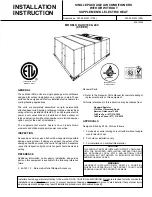
18
| Kaden Installation Manual
Step 6: Wrap piping and cables
Before passing the piping, drain hose, and the signal cable
through the wall hole, you must bundle them together to save
space, protect them, and insulate them.
1. Bundle the drain hose, refrigerant pipes, and signal cable.
Drain hose must be on bottom
Make sure that the drain hose is at the bottom of the
bundle. Putting the drain hose at the top of the bundle can
cause the drain pan to overflow, which can lead to fire or
water damage.
Do not intertwine signal cable with
other wires
While bundling these items together,
do not
intertwine or
cross the signal cable with any other wiring.
2. Using adhesive vinyl tape, attach the drain hose to the
underside of the refrigerant pipes.
3. Using insulation tape, wrap the signal wire, refrigerant
pipes, and drain hose tightly together.
Do not wrap ends of piping
When wrapping the bundle, keep the ends of the piping
unwrapped. You need to access them to test for leaks
during of the installation process (refer to Electrical checks
and Leak checks section of this manual).
Step 7: Mount indoor unit
If you installed new connective piping to the outdoor unit,
do the following:
1. If you have already passed the refrigerant piping through
the hole in the wall, proceed to Step 4.
2. Otherwise, double-check that the ends of the refrigerant
pipes are sealed to prevent dirt or foreign materials from
entering the pipes.
3. Slowly pass the wrapped bundle of refrigerant pipes, drain
hose, and signal wire through the hole in the wall.
4. Hook the top of the indoor unit on the upper hook of the
mounting plate.
5. Check that unit is hooked firmly on mounting by applying
slight pressure to the left and right-hand sides of the unit.
The unit should not jiggle or shift.
6. Using even pressure, push down on the bottom half of
the unit. Keep pushing down until the unit snaps onto the
hooks along the bottom of the mounting plate.
7. Again, check that the unit is firmly mounted by applying
slight pressure to the left and the right-hand sides of
the unit.
If refrigerant piping is already roughed into
the wall
New refrigerant piping must be used as older piping may
not meet the safe working pressure requirements of R32.
Residual mineral oil in existing pipe work is not compatible
with R32 and POE oil.
1. Hook the top of the indoor unit on the upper hook of the
mounting plate.
2. Use a bracket or wedge to prop up the unit, giving you
enough room to connect the refrigerant piping, signal cable,
and drain hose.
3. Connect drain hose and refrigerant piping (refer to
refrigerant piping connection section of this manual
for instructions).
4. Keep pipe connection point exposed to perform the leak
test (refer to Electrical checks and Leak checks section
of this manual).
5. After the leak test, wrap the connection point with
insulation tape.
6. Remove the bracket or wedge that is propping up the unit.
7. Using even pressure, push down on the bottom half of
the unit. Keep pushing down until the unit snaps onto the
hooks along the bottom of the mounting plate.
Space behind unit
Insulation tape
Refrigerant
piping
Drain hose
Signal wire
Indoor unit
















































